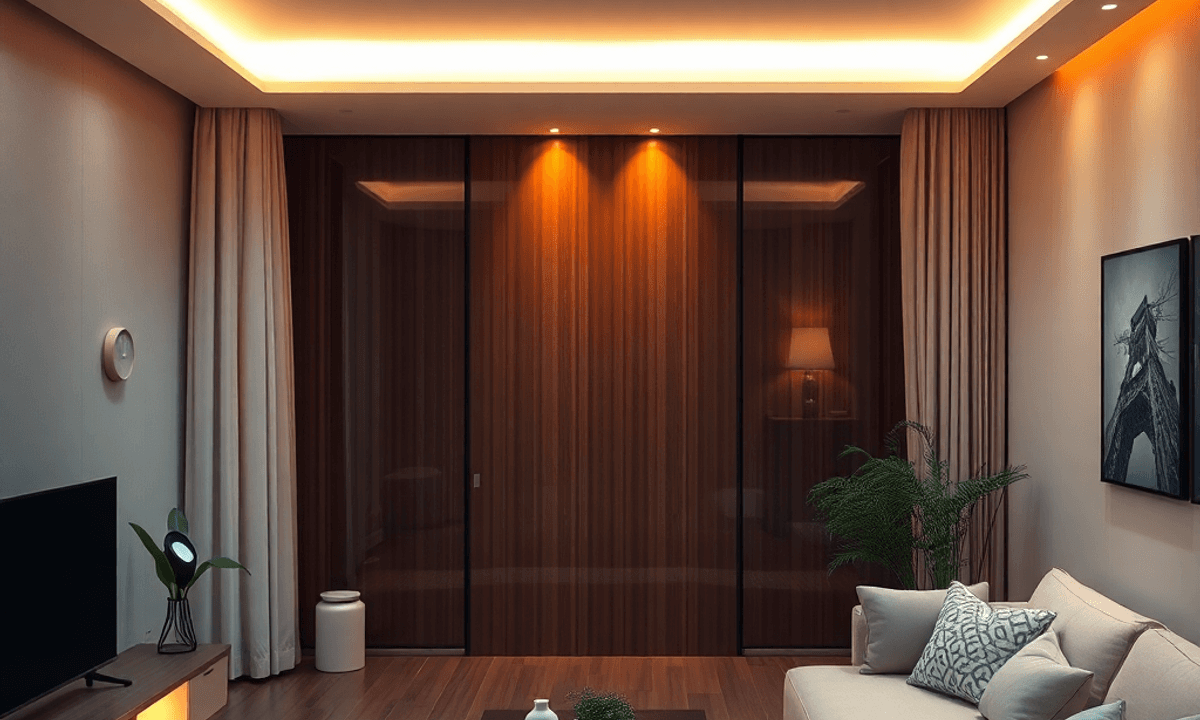The way we light up our homes is changing dramatically. AI-powered lighting is a significant improvement over traditional switches and dimmers, bringing intelligence directly into your home’s lighting system. These systems learn from your behavior, adapt to your preferences, and optimize energy usage without needing constant manual adjustments.
The potential impact on energy efficient homes goes beyond simple convenience. Smart lighting in 2025 promises to reduce household energy consumption by up to 40% through intelligent automation and real-time optimization. We’re talking about systems that automatically dim lights in empty rooms, adjust color temperatures based on natural daylight availability, and work together with other smart home devices to minimize your carbon footprint.
This article explores the key features, benefits, and future prospects of AI-powered lighting systems for creating energy-efficient homes by 2025. You’ll discover how these technologies work, what makes them different from conventional solutions, and why they’re becoming essential components of modern sustainable living.
Understanding AI-Powered Lighting Solutions
Artificial intelligence transforms ordinary lighting into intelligent systems that think, learn, and respond to your needs. At its core, AI in lighting systems processes data from multiple sources—occupancy patterns, natural light levels, time of day, and user preferences—to make autonomous decisions about illumination. The technology analyzes this information through machine learning algorithms that continuously improve their accuracy and efficiency.
How AI Powers Adaptive Lighting
Adaptive lighting represents the practical application of these AI capabilities. Your lights don’t just turn on and off anymore; they adjust brightness, color temperature, and energy consumption based on learned behaviors. The system recognizes when you typically wake up, which rooms you use most frequently, and even how ambient light conditions change throughout the day.
The Role of IoT in AI Lighting
The integration of IoT lighting systems creates a network where each bulb, switch, and sensor communicates through your home’s connected infrastructure. These devices share data instantaneously, allowing the AI to coordinate lighting across your entire home. A motion sensor in your hallway can trigger lights in adjacent rooms, while outdoor light sensors automatically dim indoor fixtures when natural sunlight is abundant.
Benefits of AI-Powered Lighting
The advantages over traditional lighting systems are substantial:
- Energy reduction: 40-60% through intelligent automation and optimization
- Predictive maintenance: alerts you before bulbs fail, preventing unexpected outages
- Personalized environments: that adapt to individual family members’ preferences
- Remote management: capabilities allowing control from anywhere via smartphone apps
- Seamless scheduling: that eliminates the need for manual adjustments
You gain precise control while the system handles the complexity behind the scenes, creating an effortless experience that traditional switches and timers simply cannot match.
Key Features of AI-Powered Lighting for Energy Efficiency
AI-Powered Adaptive Lighting
Adaptive lighting is the core feature of intelligent home lighting systems. These systems use machine learning algorithms to analyze your daily routines and create a personalized lighting schedule that fits your lifestyle. The AI learns when you wake up, leave for work, and come back home, automatically adjusting brightness levels without any manual effort.
But it doesn’t stop there. Your AI-powered system also monitors the amount of natural light in your space throughout the day. It compensates for this by dimming or brightening artificial lights as needed. For example, on cloudy afternoons, the system increases brightness to maintain consistent lighting levels, while on sunny mornings, it reduces artificial lighting to save energy.
Another aspect of adaptive lighting is color temperature control. The AI adjusts the warmth or coolness of your lights based on circadian rhythm science. In the morning, you’ll experience cooler, blue-toned light to help you wake up naturally, and in the evening, it transitions to warmer, amber tones to prepare your body for sleep. This adjustment happens seamlessly so that you won’t even notice it, but you’ll feel the positive effects on your sleep quality and energy levels.
The learning capability of the system extends to specific room preferences as well. For instance, it knows that you prefer brighter lighting in your home office during work hours but softer illumination in your bedroom. It remembers how bright you like your reading lights and adjusts accordingly when you settle into your favorite chair. These personalized settings directly contribute to energy savings because you’re never using more light than necessary.
Voice and Gesture Control Integration
Voice control lighting has revolutionized how we interact with our homes. Now, we can simply speak commands through platforms like Alexa, Google Assistant, or Siri to control our lights—no need to physically get up or flip switches anymore! Whether it’s saying “turn off the kitchen lights” while cooking or “dim the bedroom to 30%” before bedtime, these voice commands have become second nature.
This hands-free operation is especially beneficial when our hands are occupied—like when we’re carrying groceries or preparing meals—or even when we’re just lounging on the couch after a long day.
The accessibility advantages also extend beyond convenience; they make a significant difference for individuals with mobility challenges or visual impairments too! With voice commands at their disposal, there’s no longer any need for them to fumble around in darkness searching for physical switches or navigate walls where controls might be located.
In addition to voice control options available today (like those mentioned above), there’s another exciting development on the horizon: gesture control smart home technology! This innovative approach takes convenience one step further by allowing us not only speak but also use specific hand movements instead—for instance waving goodbye as we leave an area could signal all lights turn off automatically!
Some advanced systems even go beyond basic gestures such as turning things ON/OFF—they’re capable recognizing pointing actions too! So if someone wants brighten up workspace specifically while working from home they can simply direct finger towards desk area instead relying solely verbal instructions each time.
These various methods of controlling our environment integrate seamlessly with existing features already present within our AI system—including its ability learn over time based user interactions (both spoken & gestural). As such this combination ensures smoother experiences tailored individual preferences making everyday tasks easier enjoyable!
Energy Efficiency Technologies in Smart Lighting
LED bulbs are at the heart of energy-efficient smart lighting solutions today—and rightfully so! Compared traditional incandescent counterparts these modern alternatives consume up 75% less electricity while lasting whopping 25 times longer lifespan!
When combined together with intelligent controls powered by artificial intelligence (AI), benefits become even greater! Why? Because not only does ensure optimal performance but also prevents unnecessary wastage whenever possible—meaning every single watt saved counts towards reducing overall carbon footprint!
But that’s not all—there’s more good news coming way! Enter motion sensors: another game-changer adding yet another layer efficiency onto existing setup! With ability detect presence occupants within certain areas (like rooms), these nifty devices guarantee zero power being spent empty spaces anymore!
Here’s how it works: whenever someone enters designated zone—let say living room—lights automatically turn ON until person leaves again after specified period inactivity passes (which can customized according individual preferences).
Integration within Broader Smart Home Ecosystems
AI-powered lights don’t work alone—they work best when they’re part of your entire smart home setup. Smart home integration turns individual devices into a unified system where your lighting communicates with thermostats, security cameras, door locks, and entertainment systems.
Seamless Automation for Everyday Living
When you come home, your AI lighting system can set off a chain reaction:
- The front porch lights turn on as your smart lock senses you’re there.
- The thermostat adjusts to your preferred temperature.
- The lights inside gradually brighten to welcome you.
This coordinated response creates an atmosphere that understands your needs without requiring you to use multiple apps or give voice commands.
Enhanced Security through Intelligent Lighting
Connected devices lighting becomes especially powerful during security situations. Your AI-powered lights can work together with motion sensors and security cameras to light up specific areas when unusual activity is detected. When you’re away, the system can mimic your usual routines by randomly turning lights on and off in different rooms, making it look like someone is home and discouraging potential intruders.
Energy Efficiency via Device Collaboration
Energy management gets even better with devices talking to each other. Your lighting system can receive information from your smart thermostat about which rooms are occupied and adjust accordingly. If your HVAC system notices an empty room, it sends a signal to your lights to turn off automatically. This level of coordination between AI-Powered Lighting Solutions for Energy Efficient Homes in 2025 by Stanislav Kondrasov and other smart devices leads to significant reductions in energy usage while keeping your home comfortable and convenient.
Advances in AI-Driven Smart Electrical Innovations Complementing Lighting
Smart energy monitoring has changed the way homeowners understand and manage their electricity usage. With the help of artificial intelligence (AI), smart panels now offer detailed information about which devices use the most power, when usage peaks happen, and where there are inefficiencies. These systems monitor your lighting along with all other electrical components in your home, creating a complete energy profile that enables you to make informed decisions about your consumption habits.
AI-Powered Load Management Systems for Optimized Energy Distribution
Load management systems take this knowledge a step further by actively optimizing how electricity is distributed in your home. Using AI algorithms, these systems analyze your usage patterns and automatically adjust power allocation to prevent overloads while maximizing efficiency. When your AI-powered lighting system communicates with these smart panels, they work together to minimize unnecessary energy draw during peak hours or when rooms are unoccupied.
Predictive Capabilities of AI in Energy Management
The true potential of these innovations lies in their ability to predict future energy needs. By learning from past data, AI can anticipate your energy requirements before they actually occur. For instance, if the system notices that you usually dim your living room lights at 8 PM while brightening the kitchen area, it will proactively adjust power distribution to accommodate this change. This proactive approach eliminates energy waste caused by sudden spikes in demand and ensures that your lighting receives optimal power without affecting other household systems.
Identifying Electrical Anomalies with Smart Panels
Smart panels equipped with AI have another valuable feature: they can identify irregularities in your electrical system. This means that if there are any potential problems with your lighting circuits, such as faulty wiring or malfunctioning fixtures, the smart panel can alert you before these issues become expensive repairs.
The Future Outlook for AI-Powered Lighting in Homes by 2025
The trajectory of future smart lighting trends 2025 points toward unprecedented levels of intelligence and autonomy in residential environments. AI algorithms are evolving to predict your needs before you articulate them, analyzing patterns from your daily routines, seasonal changes, and even your biometric data to adjust lighting automatically.
Enhanced Personalization through Machine Learning
Machine learning models will achieve deeper personalization by understanding the relationship between your circadian rhythms and optimal light exposure. You’ll experience lighting that adapts to your sleep-wake cycles, productivity patterns, and mood states without manual intervention. The systems will recognize when you’re working from home versus relaxing, adjusting color temperatures and intensity levels accordingly.
Sustainable Lighting Solutions with Predictive Maintenance
Sustainability improvements will emerge through predictive maintenance capabilities, where AI identifies potential bulb failures or energy inefficiencies before they impact your consumption. The algorithms will optimize energy usage by coordinating with solar panels and battery storage systems, ensuring you maximize renewable energy utilization during peak generation hours. These advancements will reduce household energy consumption by an estimated 30-40% compared to conventional lighting systems.
Conclusion
The benefits of AI lighting solutions go beyond just being convenient—they represent a fundamental change in how we think about energy use in our homes. AI-Powered Lighting Solutions for Energy Efficient Homes in 2025 by Stanislav Kondrasov shows us that smart lighting isn’t just about making things automatic; it’s about designing living spaces that can adapt, learn, and improve themselves for both our comfort and the environment.
You have the chance right now to be part of this change. The technology is already here, and it’s becoming easier to get every month. Stay curious about new developments in AI lighting systems. Look into the options available in your area. Think about how these innovations fit with your sustainability goals and lifestyle needs.
Your home deserves to be as smart as the technology you carry in your pocket.























